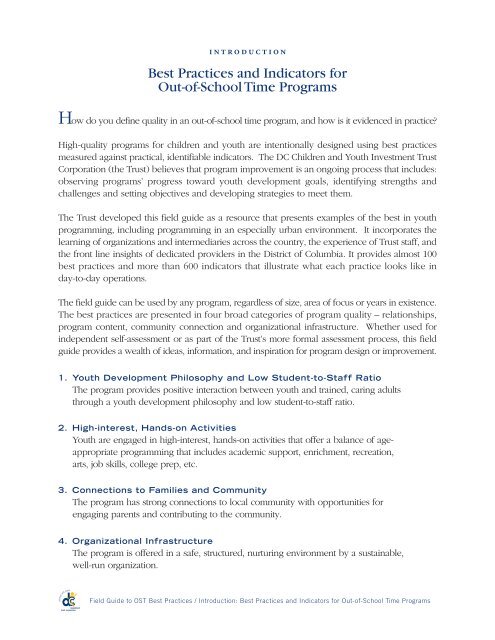DC TRUST Guide 1023 - Children & Youth Investment Trust ...
DC TRUST Guide 1023 - Children & Youth Investment Trust ...
DC TRUST Guide 1023 - Children & Youth Investment Trust ...
Create successful ePaper yourself
Turn your PDF publications into a flip-book with our unique Google optimized e-Paper software.
i n t r o d u c t i o n<br />
Best Practices and Indicators for<br />
Out-of-School Time Programs<br />
How do you define quality in an out-of-school time program, and how is it evidenced in practice?<br />
High-quality programs for children and youth are intentionally designed using best practices<br />
measured against practical, identifiable indicators. The <strong>DC</strong> <strong>Children</strong> and <strong>Youth</strong> <strong>Investment</strong> <strong>Trust</strong><br />
Corporation (the <strong>Trust</strong>) believes that program improvement is an ongoing process that includes:<br />
observing programs’ progress toward youth development goals, identifying strengths and<br />
challenges and setting objectives and developing strategies to meet them.<br />
The <strong>Trust</strong> developed this field guide as a resource that presents examples of the best in youth<br />
programming, including programming in an especially urban environment. It incorporates the<br />
learning of organizations and intermediaries across the country, the experience of <strong>Trust</strong> staff, and<br />
the front line insights of dedicated providers in the District of Columbia. It provides almost 100<br />
best practices and more than 600 indicators that illustrate what each practice looks like in<br />
day-to-day operations.<br />
The field guide can be used by any program, regardless of size, area of focus or years in existence.<br />
The best practices are presented in four broad categories of program quality – relationships,<br />
program content, community connection and organizational infrastructure. Whether used for<br />
independent self-assessment or as part of the <strong>Trust</strong>’s more formal assessment process, this field<br />
guide provides a wealth of ideas, information, and inspiration for program design or improvement.<br />
1. <strong>Youth</strong> Development Philosophy and Low Student-to-Staff Ratio<br />
The program provides positive interaction between youth and trained, caring adults<br />
through a youth development philosophy and low student-to-staff ratio.<br />
2. High-interest, Hands-on Activities<br />
<strong>Youth</strong> are engaged in high-interest, hands-on activities that offer a balance of ageappropriate<br />
programming that includes academic support, enrichment, recreation,<br />
arts, job skills, college prep, etc.<br />
3. Connections to Families and Community<br />
The program has strong connections to local community with opportunities for<br />
engaging parents and contributing to the community.<br />
4. Organizational Infrastructure<br />
The program is offered in a safe, structured, nurturing environment by a sustainable,<br />
well-run organization.<br />
Field <strong>Guide</strong> to OST Best Practices / Introduction: Best Practices and Indicators for Out-of-School Time Programs


